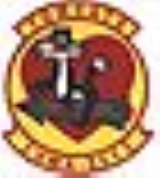
VMA-311
Encyclopedia
Marine Attack Squadron 311 (VMA-311) is a United States Marine Corps
fighter squadron consisting of AV-8B Harrier (V/STOL
) jets
. Known as the "Tomcats", the squadron is based at Marine Corps Air Station Yuma
, Arizona
and falls under the command of Marine Aircraft Group 13
(MAG-13) and the 3rd Marine Aircraft Wing
(3rd MAW).
 Born during the national call-to-arms immediately following the Japanese attack on Pearl Harbor
Born during the national call-to-arms immediately following the Japanese attack on Pearl Harbor
, Marine Fighting Squadron 311 (VMF-311) was first commissioned on 1 December 1942, assigned to the 3rd Marine Aircraft Wing
and headquartered at MCAS Cherry Point
. Quickly transitioning from a training squadron flying the SNJ Texan
to a combat squadron flying the F4U Corsair
, VMF-311 participated in what was one of the earliest American catapult operations involving the Corsair when 21 F4U’s launched from the USS Nassau (CVE-16)
on October 6, 1943. By this time the squadron formed part of MAG-31
. During World War II
, VMF-311 was one of the first to utilize and develop tactics for the Corsair in a ground attack
mode, foreshadowing the squadron’s future role as an attack squadron. Indicative of its combat effectiveness the squadron destroyed 71 Japanese aircraft in a four-month period during the Battle of Okinawa
in 1945. The end of World War II saw VMF-311 leaving Chimu airfield on Okinawa to start occupational duty flying from Yokosuka airfield on Japan's mainland.
 Occupational duty in Japan lasted till May 1946, when MAG-31 was notified to prepare for the termination of its Japanese assignment; VMF-311 was going home. Between July 1946 and Aril 1947 the squadron had a sleeping existence and being transferred to MAG-32 and later MAG-12 while consisting of one officer, but in 1949 VMF-311 became the first West Coast Marine jet squadron when it started flying the TO-1 Shooting Star
Occupational duty in Japan lasted till May 1946, when MAG-31 was notified to prepare for the termination of its Japanese assignment; VMF-311 was going home. Between July 1946 and Aril 1947 the squadron had a sleeping existence and being transferred to MAG-32 and later MAG-12 while consisting of one officer, but in 1949 VMF-311 became the first West Coast Marine jet squadron when it started flying the TO-1 Shooting Star
. Coincidentally the squadron was re-designated Marine Fighter Squadron 311 (VMF-311) and around that time acquired the code letters WL, phonetically pronounced as "William Love", but from which also came the nickname "Willy Lovers". The squadron quickly transitioned to the F9F Panther
in October 1949 and found itself once again preparing for war by November 1950, arriving once again at Yokusuka airfield in Japan.

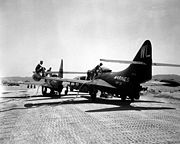 Arriving in Korea
Arriving in Korea
on December 7, 1950, VMF-311 was the first land-based Marine jet squadron to be used in combat providing close air support
for the Marines and Soldiers on the ground. In late-June 1952 the squadron participate in the attack on the Sui-ho Dam
. Additionally the squadron pioneered strip-alert tactics still practiced today. Legendary pilots during this era included later Astronaut and Senator John Glenn
and baseball star Ted Williams
. In over 2½ years of action in Korea the squadron amassed 18,851 combat sorties. In 1957, the squadron finally was re-designated Marine Attack Squadron 311 (VMA-311). The nickname “Tomcats” was also bestowed during this era.
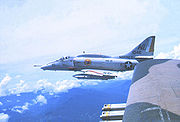 The first A4D-2 Skyhawk was received by the "Tomcats" in the summer of 1958, initiating 30 years of Skyhawk service. In May of 1965 the squadron, now flying A4E's, deployed to Chu Lai
The first A4D-2 Skyhawk was received by the "Tomcats" in the summer of 1958, initiating 30 years of Skyhawk service. In May of 1965 the squadron, now flying A4E's, deployed to Chu Lai
in the Republic of Vietnam and on June 2, they conducted their first combat mission of the Vietnam War. In August 1965, VMA-311 supported the 7th Marine Regiment in Operation Starlite
-- the first major American operation of the war. After almost eight years of operations in Vietnam the Tomcats totaled 54,625 combat sorties before leaving in January 1973. Among the sortie count was an amazing four-day sortie total of 240 from 5 to 8 May 1968 in support of their fellow marines during the Battle of Khe Sahn. During most of their time they were based at Chu Lai
. The squadron flew the last Marine Corps sorties out of Chu Lai on September 11, 1970. In May 1972 VMA-311 once again deployed to Vietnam with MAG-12 Forward at Bien Hoa, Vietnam. Their final sortie in-country would occur on January 29, 1973and a day before they would drop the last ordnance from a Marine A-4 Skyhawk during the war. VMA-311 would fly 54,625 combat sorties during their time supporting operations in Vietnam, Laos and Cambodia.
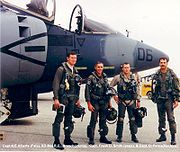 In 1988 VMA-311 received its first AV-8B Harrier and shortly thereafter headed into harm’s way again. On August 11, 1990, after the Iraq
In 1988 VMA-311 received its first AV-8B Harrier and shortly thereafter headed into harm’s way again. On August 11, 1990, after the Iraq
i invasion of Kuwait
, VMA-311 deployed in support of Operation Desert Shield, leading all other Marine fixed-wing squadrons into Saudi Arabia
where they were based out of King Abdulaziz Naval Base
. While there, the Tomcats were the most forward deployed fixed-wing squadron. On January 17, 1991 while in support of Operation Desert Storm the squadron became the first to utilize the AV-8B in combat when a flight of four Harriers destroyed an Iraqi artillery
position in support of the Battle of Khafji. During 43 days of air combat operations, Tomcat pilots flew 1,017 combat missions and delivered 840 tons of ordnance against enemy targets throughout Kuwait and Southern Iraq.
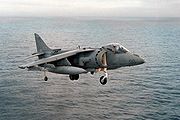
embarked aboard the USS Peleliu became the first Harriers to fly combat missions in Afghanistan
during Operation Enduring Freedom.
On January 15, 2003, the Marines of VMA-311 deployed to the Northern Persian Gulf
as part of Amphibious Task Force West. On March 21, 2003, almost 59 years to the day after VMF-311’s first combat sortie in World War II
, the Tomcats flew their first combat sortie of Operation Iraqi Freedom. During the war they flew over 550 sorties while dropping 77 tons of precision ordnance, destroying or neutralizing 132 Iraqi targets while operating from two amphibious assault carriers, the USS Bonhomme Richard
and the USS Tarawa
. The Tomcats returned from the Persian Gulf on July 24, 2003. In 2008, they later deployed in support of the 15th Marine Expeditionary Unit, while simultaneously sending a detachment of Marines and Harriers to Iraq in support of Operation Iraqi Freedom. These deployments were soon followed in 2010 with deployments again to the 15th MEU, and a Unit Deployment Program to the Pacific region. While there, the Tomcats spent over 2 months aboard the USS Essex with the 31st MEU while participating in the multilateral exercises Cobra Gold 2010 and Balikatan 2010.
credited with shooting down five or more enemy aircraft
during aerial combat. The following Marines from VMA-311 have been credited with more than five victories:
United States Marine Corps
The United States Marine Corps is a branch of the United States Armed Forces responsible for providing power projection from the sea, using the mobility of the United States Navy to deliver combined-arms task forces rapidly. It is one of seven uniformed services of the United States...
fighter squadron consisting of AV-8B Harrier (V/STOL
V/STOL
Vertical and/or short take-off and landing is a term used to describe aircraft that are able to take-off or land vertically or on short runways. Vertical takeoff and landing describes craft which do not require runways at all...
) jets
Turbofan
The turbofan is a type of airbreathing jet engine that is widely used for aircraft propulsion. A turbofan combines two types of engines, the turbo portion which is a conventional gas turbine engine, and the fan, a propeller-like ducted fan...
. Known as the "Tomcats", the squadron is based at Marine Corps Air Station Yuma
Marine Corps Air Station Yuma
Marine Corps Air Station Yuma or MCAS Yuma is a United States Marine Corps air station which is the home to multiple squadrons of AV-8B Harrier IIs of the 3rd Marine Aircraft Wing, Marine Aviation Weapons and Tactics Squadron 1 and Marine Fighter Training Squadron 401 , an air combat adversary...
, Arizona
Arizona
Arizona ; is a state located in the southwestern region of the United States. It is also part of the western United States and the mountain west. The capital and largest city is Phoenix...
and falls under the command of Marine Aircraft Group 13
Marine Aircraft Group 13
Marine Aircraft Group 13 is a United States Marine Corps aviation unit based at Marine Corps Air Station Yuma that is currently composed of four AV-8B Harrier squadrons and a maintenance and logistics squadron...
(MAG-13) and the 3rd Marine Aircraft Wing
3rd Marine Aircraft Wing
The 3d Marine Aircraft Wing is the major west coast aviation unit of the United States Marine Corps. It is headquartered at Marine Corps Air Station Miramar, California and provides the aviation combat element for I Marine Expeditionary Force...
(3rd MAW).
World War II

Attack on Pearl Harbor
The attack on Pearl Harbor was a surprise military strike conducted by the Imperial Japanese Navy against the United States naval base at Pearl Harbor, Hawaii, on the morning of December 7, 1941...
, Marine Fighting Squadron 311 (VMF-311) was first commissioned on 1 December 1942, assigned to the 3rd Marine Aircraft Wing
3rd Marine Aircraft Wing
The 3d Marine Aircraft Wing is the major west coast aviation unit of the United States Marine Corps. It is headquartered at Marine Corps Air Station Miramar, California and provides the aviation combat element for I Marine Expeditionary Force...
and headquartered at MCAS Cherry Point
Marine Corps Air Station Cherry Point
Marine Corps Air Station Cherry Point or MCAS Cherry Point is a United States Marine Corps airfield located in Havelock, North Carolina, USA, in the eastern part of the state...
. Quickly transitioning from a training squadron flying the SNJ Texan
T-6 Texan
The North American Aviation T-6 Texan was a single-engine advanced trainer aircraft used to train pilots of the United States Army Air Forces, United States Navy, Royal Air Force and other air forces of the British Commonwealth during World War II and into the 1950s...
to a combat squadron flying the F4U Corsair
F4U Corsair
The Vought F4U Corsair was a carrier-capable fighter aircraft that saw service primarily in World War II and the Korean War. Demand for the aircraft soon overwhelmed Vought's manufacturing capability, resulting in production by Goodyear and Brewster: Goodyear-built Corsairs were designated FG and...
, VMF-311 participated in what was one of the earliest American catapult operations involving the Corsair when 21 F4U’s launched from the USS Nassau (CVE-16)
USS Nassau (CVE-16)
The USS Nassau was laid down 27 November 1941 by the Seattle-Tacoma Shipbuilding Corporation of Tacoma, Washington, as M.C. Hull No. 234; launched 4 April 1942; sponsored by Mrs. G. H...
on October 6, 1943. By this time the squadron formed part of MAG-31
Marine Aircraft Group 31
Marine Aircraft Group 31 is a United States Marine Corps aviation group based at Marine Corps Air Station Beaufort, South Carolina that is currently composed of four F/A-18C squadrons, one F/A-18A+ squadron, two F/A-18D squadrons and a maintenance and logistics squadron...
. During World War II
World War II
World War II, or the Second World War , was a global conflict lasting from 1939 to 1945, involving most of the world's nations—including all of the great powers—eventually forming two opposing military alliances: the Allies and the Axis...
, VMF-311 was one of the first to utilize and develop tactics for the Corsair in a ground attack
Close air support
In military tactics, close air support is defined as air action by fixed or rotary winged aircraft against hostile targets that are close to friendly forces, and which requires detailed integration of each air mission with fire and movement of these forces.The determining factor for CAS is...
mode, foreshadowing the squadron’s future role as an attack squadron. Indicative of its combat effectiveness the squadron destroyed 71 Japanese aircraft in a four-month period during the Battle of Okinawa
Battle of Okinawa
The Battle of Okinawa, codenamed Operation Iceberg, was fought on the Ryukyu Islands of Okinawa and was the largest amphibious assault in the Pacific War of World War II. The 82-day-long battle lasted from early April until mid-June 1945...
in 1945. The end of World War II saw VMF-311 leaving Chimu airfield on Okinawa to start occupational duty flying from Yokosuka airfield on Japan's mainland.
1946-1950

P-80 Shooting Star
The Lockheed P-80 Shooting Star was the first jet fighter used operationally by the United States Army Air Forces. Designed in 1943 as a response to the German Messerschmitt Me-262 jet fighter, and delivered in just 143 days from the start of the design process, production models were flying but...
. Coincidentally the squadron was re-designated Marine Fighter Squadron 311 (VMF-311) and around that time acquired the code letters WL, phonetically pronounced as "William Love", but from which also came the nickname "Willy Lovers". The squadron quickly transitioned to the F9F Panther
F9F Panther
|-Popular culture:The Panther played a prominent role in the 1954 movie Men of the Fighting Lady . The F9F was featured in the flying sequences in the 1954 movie The Bridges at Toko-Ri, although in the 1953 James A...
in October 1949 and found itself once again preparing for war by November 1950, arriving once again at Yokusuka airfield in Japan.
The Korean War, 1950-1955


Korea
Korea ) is an East Asian geographic region that is currently divided into two separate sovereign states — North Korea and South Korea. Located on the Korean Peninsula, Korea is bordered by the People's Republic of China to the northwest, Russia to the northeast, and is separated from Japan to the...
on December 7, 1950, VMF-311 was the first land-based Marine jet squadron to be used in combat providing close air support
Close air support
In military tactics, close air support is defined as air action by fixed or rotary winged aircraft against hostile targets that are close to friendly forces, and which requires detailed integration of each air mission with fire and movement of these forces.The determining factor for CAS is...
for the Marines and Soldiers on the ground. In late-June 1952 the squadron participate in the attack on the Sui-ho Dam
Attack on the Sui-ho Dam
The attack on the Sui-ho Dam was the collective name for a large series of air attacks by United Nations Command air forces on thirteen hydroelectric generating facilities that took place June 23 and June 24, 1952, during the Korean War...
. Additionally the squadron pioneered strip-alert tactics still practiced today. Legendary pilots during this era included later Astronaut and Senator John Glenn
John Glenn
John Herschel Glenn, Jr. is a former United States Marine Corps pilot, astronaut, and United States senator who was the first American to orbit the Earth and the third American in space. Glenn was a Marine Corps fighter pilot before joining NASA's Mercury program as a member of NASA's original...
and baseball star Ted Williams
Ted Williams
Theodore Samuel "Ted" Williams was an American professional baseball player and manager. He played his entire 21-year Major League Baseball career as the left fielder for the Boston Red Sox...
. In over 2½ years of action in Korea the squadron amassed 18,851 combat sorties. In 1957, the squadron finally was re-designated Marine Attack Squadron 311 (VMA-311). The nickname “Tomcats” was also bestowed during this era.
Vietnam War

Chu Lai
Chu Lai is a sea port, urban and industrial area in Dung Quat Bay, Núi Thành district, Quang Nam province of Vietnam. The city is served by Chu Lai Airport.-Vietnam War:...
in the Republic of Vietnam and on June 2, they conducted their first combat mission of the Vietnam War. In August 1965, VMA-311 supported the 7th Marine Regiment in Operation Starlite
Operation Starlite
Operation Starlite was the first offensive military action conducted by a purely U.S. military unit during the Vietnam War. The operation was launched based on intelligence provided by Major General Nguyen Chanh Thi, the commander of the South Vietnamese forces in northern I Corps area. Lieutenant...
-- the first major American operation of the war. After almost eight years of operations in Vietnam the Tomcats totaled 54,625 combat sorties before leaving in January 1973. Among the sortie count was an amazing four-day sortie total of 240 from 5 to 8 May 1968 in support of their fellow marines during the Battle of Khe Sahn. During most of their time they were based at Chu Lai
Chu Lai
Chu Lai is a sea port, urban and industrial area in Dung Quat Bay, Núi Thành district, Quang Nam province of Vietnam. The city is served by Chu Lai Airport.-Vietnam War:...
. The squadron flew the last Marine Corps sorties out of Chu Lai on September 11, 1970. In May 1972 VMA-311 once again deployed to Vietnam with MAG-12 Forward at Bien Hoa, Vietnam. Their final sortie in-country would occur on January 29, 1973and a day before they would drop the last ordnance from a Marine A-4 Skyhawk during the war. VMA-311 would fly 54,625 combat sorties during their time supporting operations in Vietnam, Laos and Cambodia.
The Gulf War

Iraq
Iraq ; officially the Republic of Iraq is a country in Western Asia spanning most of the northwestern end of the Zagros mountain range, the eastern part of the Syrian Desert and the northern part of the Arabian Desert....
i invasion of Kuwait
Kuwait
The State of Kuwait is a sovereign Arab state situated in the north-east of the Arabian Peninsula in Western Asia. It is bordered by Saudi Arabia to the south at Khafji, and Iraq to the north at Basra. It lies on the north-western shore of the Persian Gulf. The name Kuwait is derived from the...
, VMA-311 deployed in support of Operation Desert Shield, leading all other Marine fixed-wing squadrons into Saudi Arabia
Saudi Arabia
The Kingdom of Saudi Arabia , commonly known in British English as Saudi Arabia and in Arabic as as-Sa‘ūdiyyah , is the largest state in Western Asia by land area, constituting the bulk of the Arabian Peninsula, and the second-largest in the Arab World...
where they were based out of King Abdulaziz Naval Base
King Abdulaziz Naval Base
The King Abdul-Aziz Naval Base is a naval base in the Eastern Province Royal Saudi Naval Forces .It is home to the Eastern Fleet and the Naval Academy. Their Navy Ratings "SK" and "YN" learned basic skills in this school....
. While there, the Tomcats were the most forward deployed fixed-wing squadron. On January 17, 1991 while in support of Operation Desert Storm the squadron became the first to utilize the AV-8B in combat when a flight of four Harriers destroyed an Iraqi artillery
Artillery
Originally applied to any group of infantry primarily armed with projectile weapons, artillery has over time become limited in meaning to refer only to those engines of war that operate by projection of munitions far beyond the range of effect of personal weapons...
position in support of the Battle of Khafji. During 43 days of air combat operations, Tomcat pilots flew 1,017 combat missions and delivered 840 tons of ordnance against enemy targets throughout Kuwait and Southern Iraq.

Global War on Terror
On November 3, 2001, VMA-311 Harriers attached to the 15th Marine Expeditionary Unit15th Marine Expeditionary Unit
The 15th Marine Expeditionary Unit is one of seven Marine Expeditionary Units currently in existence in the United States Marine Corps. The Marine Expeditionary Unit is a Marine Air Ground Task Force with a strength of about 2,200 personnel...
embarked aboard the USS Peleliu became the first Harriers to fly combat missions in Afghanistan
Afghanistan
Afghanistan , officially the Islamic Republic of Afghanistan, is a landlocked country located in the centre of Asia, forming South Asia, Central Asia and the Middle East. With a population of about 29 million, it has an area of , making it the 42nd most populous and 41st largest nation in the world...
during Operation Enduring Freedom.
On January 15, 2003, the Marines of VMA-311 deployed to the Northern Persian Gulf
Persian Gulf
The Persian Gulf, in Southwest Asia, is an extension of the Indian Ocean located between Iran and the Arabian Peninsula.The Persian Gulf was the focus of the 1980–1988 Iran-Iraq War, in which each side attacked the other's oil tankers...
as part of Amphibious Task Force West. On March 21, 2003, almost 59 years to the day after VMF-311’s first combat sortie in World War II
World War II
World War II, or the Second World War , was a global conflict lasting from 1939 to 1945, involving most of the world's nations—including all of the great powers—eventually forming two opposing military alliances: the Allies and the Axis...
, the Tomcats flew their first combat sortie of Operation Iraqi Freedom. During the war they flew over 550 sorties while dropping 77 tons of precision ordnance, destroying or neutralizing 132 Iraqi targets while operating from two amphibious assault carriers, the USS Bonhomme Richard
USS Bonhomme Richard (LHD-6)
USS Bonhomme Richard is an Amphibious Assault Ship, and the third United States Navy ship of that name. It was named in honor of John Paul Jones' famous frigate, which he had named the French language equivalent of "Good man Richard," in honor of Benjamin Franklin, the U.S. Ambassador to France at...
and the USS Tarawa
USS Tarawa (LHA-1)
USS Tarawa is a United States Navy amphibious assault ship, the lead ship of her class, and the second ship to be named for Tarawa Atoll, site of a Marine landing during World War II. The first Tarawa was the...
. The Tomcats returned from the Persian Gulf on July 24, 2003. In 2008, they later deployed in support of the 15th Marine Expeditionary Unit, while simultaneously sending a detachment of Marines and Harriers to Iraq in support of Operation Iraqi Freedom. These deployments were soon followed in 2010 with deployments again to the 15th MEU, and a Unit Deployment Program to the Pacific region. While there, the Tomcats spent over 2 months aboard the USS Essex with the 31st MEU while participating in the multilateral exercises Cobra Gold 2010 and Balikatan 2010.
Squadron aces
A flying ace or fighter ace is a naval aviatorNaval Aviator
A United States Naval Aviator is a qualified pilot in the United States Navy, Marine Corps or Coast Guard.-Naming Conventions:Most Naval Aviators are Unrestricted Line Officers; however, a small number of Limited Duty Officers and Chief Warrant Officers are also trained as Naval Aviators.Until 1981...
credited with shooting down five or more enemy aircraft
Aircraft
An aircraft is a vehicle that is able to fly by gaining support from the air, or, in general, the atmosphere of a planet. An aircraft counters the force of gravity by using either static lift or by using the dynamic lift of an airfoil, or in a few cases the downward thrust from jet engines.Although...
during aerial combat. The following Marines from VMA-311 have been credited with more than five victories:
- 2nd Lt. William P. Brown Jr. - 7.0
- Maj. Michael R. Yunck - 7.0 (5.0 with VMA-311)
See also
- United States Marine Corps AviationUnited States Marine Corps AviationUnited States Marine Corps Aviation is the air component of the United States Marine Corps. Marine aviation has a very different mission and operation than its ground counterpart, and thus, has many of its own histories, traditions, terms, and procedures....
- List of United States Marine Corps aircraft squadrons

